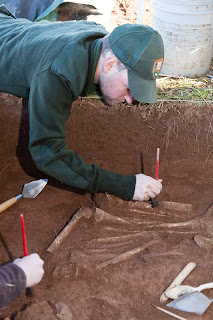 |
| Erin Godwin excavates limb / Kate D. Sherwood, Smithsonian Institution |
The extraordinary discovery of the remains of two Civil War soldiers buried next to 11 amputated limbs at Manassas National Battlefield Park in Virginia has brought new insight into how surgeons treated the critically wounded.
The National Park Service on Wednesday announced it’s the
first time a surgeon’s “limb pit” from the conflict has been excavated and
studied. It dates from the Second Battle of Bull Run in August 1862, a decisive victory for Confederates.
Bone fragments were found in an undisclosed area of the
park during a utility project in 2014. The next year, NPS and Smithsonian
Institution archaeologists excavated the site.
“Beneath the surface, they
found two nearly complete human skeletons, and several artifacts including
buttons from a Union sack coat, a .577 Enfield bullet, three pieces of .31
caliber lead buckshot, and an assemblage of eleven arms and legs,” the park
said.
 |
| Femur with lodged bullet / Kate D. Sherwood, Smithsonian Institution |
A glance of photographs of the amputated limbs shows the
bleak realities of war. Surgeons sawed them off with precision because the
bullets caused so much damage and soldiers needed an opportunity to ward off
deadly infection.
As casualties piled into tents not far from the fighting,
Civil War surgeons had to make quick decisions on who might have a chance of
going home – without an arm or leg – and who was too seriously hurt to be
operated on.
That appeared to be the case with the two soldiers.
The first was in his 20s and died of injuries from an
Enfield bullet striking his upper leg.
“Surprisingly, the bullet was still lodged in the femur bone, likely because it slowed as it passed through the man’s cartridge box, the National Park Service said.
 |
| Cut marks show surgeon's skill / Kate D. Sherwood, Smithsonian Institution |
Doug Owsley, lead physical anthropologist at the National Museum of Natural History, told the Smithsonian's online magazine that the soldier was shot in the buttocks while retreating.
The
slug went in at an angle, causing a longitudinal fracture that caused the femur to snap, with bits splintering off inside his leg.
“This is just so difficult to treat,” says Owsley, adding the wound was too high for amputation. The man was set aside and died.
The second skeleton is that of a man estimated to be
between 30 and 34 years old. He died as a result of a buck and ball shot to the
upper arm, pelvis and leg.
Regarding the amputated limbs, Owsley said the surgeon was skilled, given the precision of the cuts.
Regarding the amputated limbs, Owsley said the surgeon was skilled, given the precision of the cuts.
 |
| Brandon Bies assists in 2015 dig / Kate D. Sherwood, Smithsonian Institution |
Manassas Superintendent Brandon Bries said, “We can start
to have a personal connection to these soldiers and these remains. So instead
of some bones, you are looking at somebody who was between 30 and 34 years old
and was from the state of New York. That person may have had a wife, may have
had children.”
The NPS said research on the recovered limbs continues and its possible they could be matched with a name.
“By examining the cuts, it is possible
to determine the skill of the surgeon and even his physical position relative
to the patient. With help from historical records, researchers believe it may
be possible to match the bones with a specific surgeon and maybe even the
soldier they belonged to, a truly unique discovery.”
 |
| Bruwelheide, Bies examine bones / Nathan King, NPS |
Bies, an archaeologist, told NPR that the men were likely wounded during a charge up Deep Cut, held by thousands of Confederates. “As (Union soldiers) start to get closer, within 300, 400 yards, they start to receive rifle fire and musket fire," he says. "Men are dropping left and right."
 |
| Bullet entrance wound / Kate D. Sherwood, Smithsonian Institution |
Surgeons had a standard kit, with a variety of saws.
"If you could imagine sitting with
a horrific wound of your own and hearing the moans and screams and seeing a
growing pile of limbs from the surgeon, and knowing that your turn was coming,
I can't possibly imagine what that would have been like,” Bies told NPR.
The bones were found in a shallow pit, indicating they likely were buried in haste. According to Smithsonian experts, the surgeons were allowed by Confederates to conduct the hasty operations after the battle, when the wounded had been in the sun and rain for days. They may not have had chloroform at their disposal.
The bones were found in a shallow pit, indicating they likely were buried in haste. According to Smithsonian experts, the surgeons were allowed by Confederates to conduct the hasty operations after the battle, when the wounded had been in the sun and rain for days. They may not have had chloroform at their disposal.
 |
| Remains are in Army custody / Bradley Waldron, NPS |
 |
| Foot of amputated leg / Kate D. Sherwood, Smithsonian Institution |
No comments:
Post a Comment